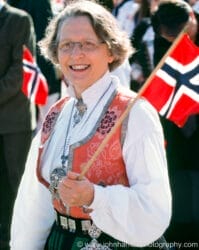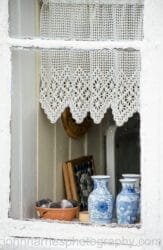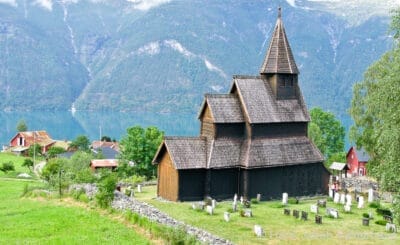Language
Most Norwegians speak English and are not at all chauvinistic about their language or resentful about being approached in English, so you will be able to communicate in English in almost all situations; however, an attempt on your part to learn a few words of Norwegian will be greatly appreciated and may very well be the start of a long-term friendship.
The Norwegian language is changing, plus there are actually two different Norwegian languages (Bokmål and Nynorsk) used in different places and, to add to the confusion, there are almost as many dialects as there are villages! This creates some problems for the non-Norwegian speaker both when trying to learn to speak Norwegian and when trying to figure out how to spell the name of a harbour.
Some Norwegian place names with the approximate pronunciation in brackets and the accent shown in bold:
Stavanger (stah-vahng-er)
Molde (mold-uh)
Gjøvik (yuh-veek)
Kristiansand (krihst-yahn-sahn)
Norge (nawr-guh)
Myrdal (meer-dahl)
Ålesund (awl-uh-soon)
Lofoten (loh-futen)
Trondheim (trohn-hae-eem)
Narvik (nahr-veek)
Dovrefjell (daw-vruh-fyel)
Oslo (os-shloh)
Jotunheimen (yoh-tuhn-hae-eem-en)
Tønsberg (tuhns-bairg)
Værøy (vaer-uh-ee)
Norsk (nawr-shk)
A few tips that might help:
- Norwegian indicates the definite form with a word ending rather than a prefixed article.
- For e.g. Sognefjorden means the Sognefjord, with “en” meaning “the”. So if you say “the Sognefjorden”, you are actually saying “the the Sognefjord”. The endings “an” and “et” are other forms of the used at the ends of words. In the Guide we have chosen to use both formats (e.g. the Sognefjord and Sognefjorden), depending on the context.
- The plural form is usually indicated by the addition of an r at the end of the word.
- For e.g. the plural of varde is varder and the plural of holmen is holmer.
- Earlier usage, often seen on old charts, is aa. This has been replaced in general usage by å.
- Island was, in the old days, written simply as ø. Present usage has evolved to øy (any island) and øya (the island). However, in real life, all three are used interchangeably and you may see a place referred to one way on the chart, a different way in Den Norske Los, and a third way in a tourist book.
- Norwegian has three more vowels than English, considered the last three letters in the Norwegian alphabet:
- æ which is pronounced like the a in cat
- ø which is pronounced like the u in mud
- å which is pronounced like the o in Minnesota
- The g is never soft and is often suppressed.
- The s is often slurred.
- The d is often silent, especially in nord, which is also true for a final t.
To really pronounce Norwegian correctly you need to be coached by a Norwegian. Of course, once you finally get the pronunciation right after numerous repetitions, you will travel 100 miles along the coast, the dialect will change, and you will have to start all over again!
Culture

There are a number of things that we learned to really appreciate about Norwegian culture during the two years we spent there:
- If we only stayed in an anchorage for just one day, we usually didn’t meet anyone. However, if we stayed for two or three days, there would almost always be a knock on the hull from someone dropping by to see if we needed anything.
- Most Norwegians will just say hei (hello) upon meeting you and only say hyggelig å treffe deg (pleased to meet you) at the end of the meeting. This is unlike our culture where we automatically say “Pleased to meet you” when we meet someone new. As our Norwegian friend said when we pointed out this difference, “But how do I know I am pleased to meet you if we’ve just met? Maybe you’ll turn out to be a jerk!”
- Norwegians also don’t tend to say “please” as much as English speakers do. However, takk (thank you) is used all the time as is vær så god (which can mean anything from “Can I help you?” to “You’re welcome”).
Holidays
Norway goes on holiday in July. This means that harbours and marinas are jammed solid, at least in the more populated areas, and getting any repairs done on your boat will be impossible during this time.
May 17th is Norway Day and, if you can arrange to be in Norway on this day, do! It says something wonderful about a country whose national day is a day for children rather than a day for the military.
Flag Etiquette

Norwegians are flag conscious, with a flagstaff on almost every country house. It is therefore important to fly the Norwegian courtesy flag and to observe proper flag etiquette.
Art and Music

When invited into a Norwegian home we were almost without exception impressed by the amount of original Norwegian art on display. This interest in Norwegian art also carries through to the public arena, and numerous harbours have outdoor art installations.
Also noticeable is the attention Norwegians pay to window ornamentation. Walking through a residential neighbourhood, especially during the darktime (mørketid) when windows are illuminated, was like walking through an outdoor art gallery!
Traditional Wooden Boats

The variety of traditional wooden boats you will see as you move along the coast is proof of Norway’s long boatbuilding and seafaring history. And it’s a history that many Norwegians are trying to keep alive, both by preserving boats in museums and by continuing to build beautiful traditional boats.

Of special interest are:
- the double-ended, clinker-built Viking longship-style Nordlands boat, which are still built and sailed extensively as pleasure craft in North Norway;
- the oselvar, a traditional rowing boat that was once western Norway’s main mode of transportation but which almost died out with the introduction of modern boats in the 1940s. It is now listed on UNESCO’s Register of Good Conservation Practices, a compendium of experiences and examples of how the transmission of living heritage has been preserved to be passed on to future generations.
Museums and Events
We list notable museums and events under the applicable Harbours and Anchorages entries, but we highly recommend you also check Visit Norway for anything we might have missed!

The Society for the Preservation of Norwegian Ancient Monuments
The Society manages numerous historical sites, including a number of medieval wooden stave churches.
Fun and/or Informative Reading
Just a few of the books about Norway that we have enjoyed:
- We Die Alone: By David Howarth, this wonderful book chronicles the story of Jan Baalsrud, a Norwegian patriot in WWII, who was smuggled in to Northern Norway by the Norwegian Resistance only to be betrayed. The rest of his group was killed but Jan managed to escape to Sweden.
- The Shetland Bus: Also by David Howarth and another book about the Norwegian Resistance in WWII, this book is an excellent overview of the whole movement, including a short vignette about Jan Baalsrud.
- Wolf Winter: Sailor turned author Clare Francis has written a wonderful murder/mystery set in Norway. A great read.
- Attention All Shipping: A Journey Round the Shipping Forecast: Charlie Connelly’s bestselling book is a wonderful romp through the North Sea shipping forecast areas.

